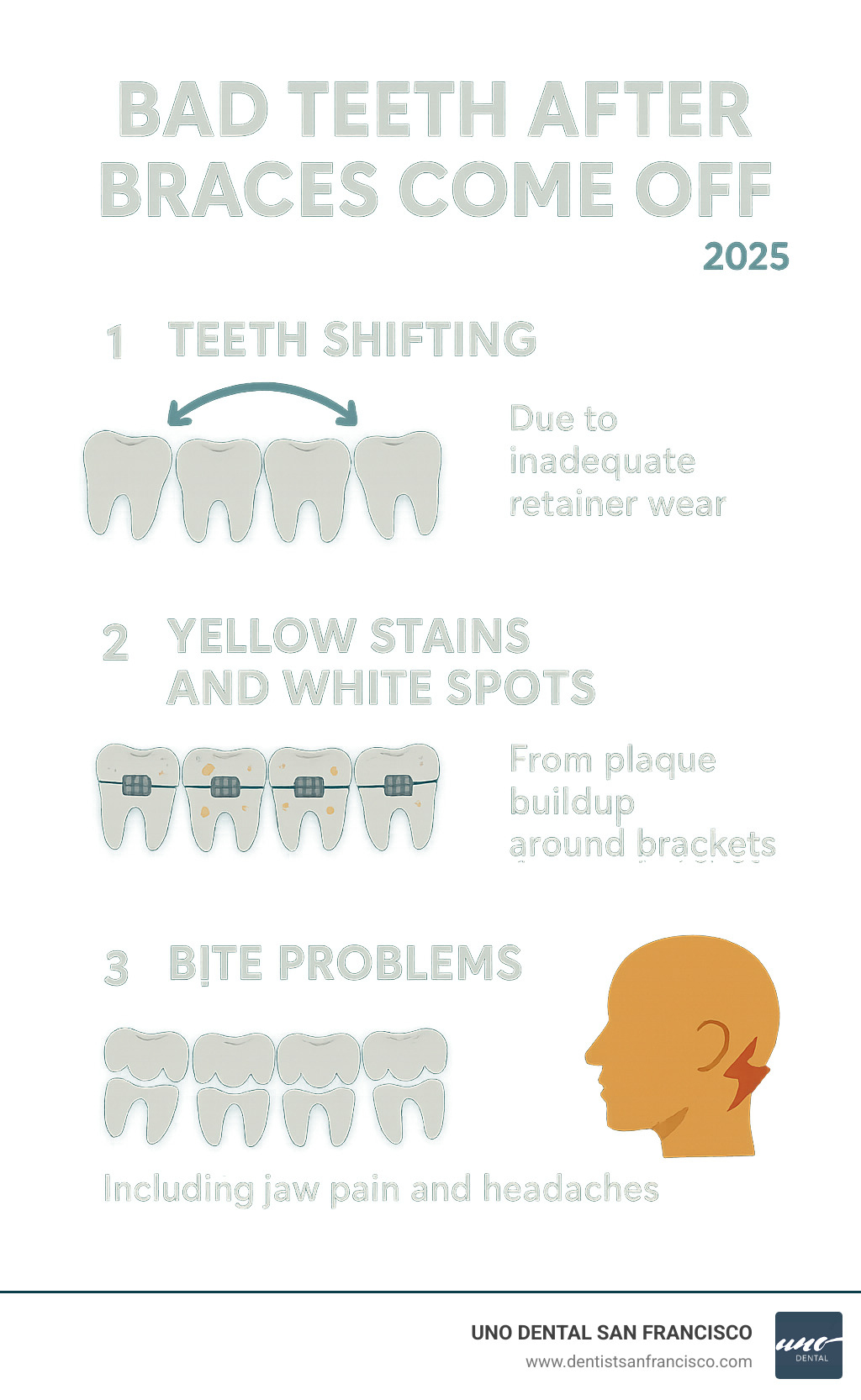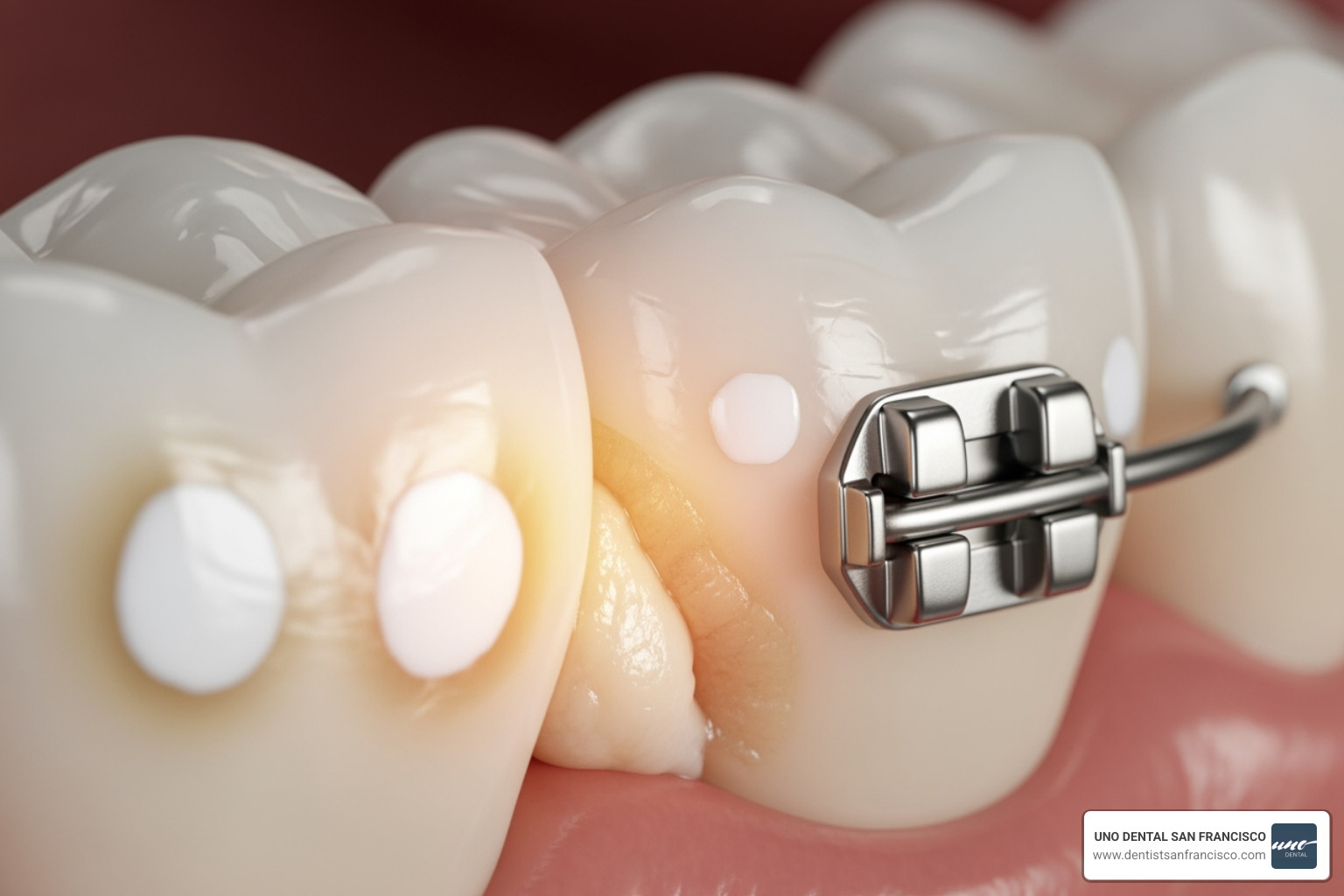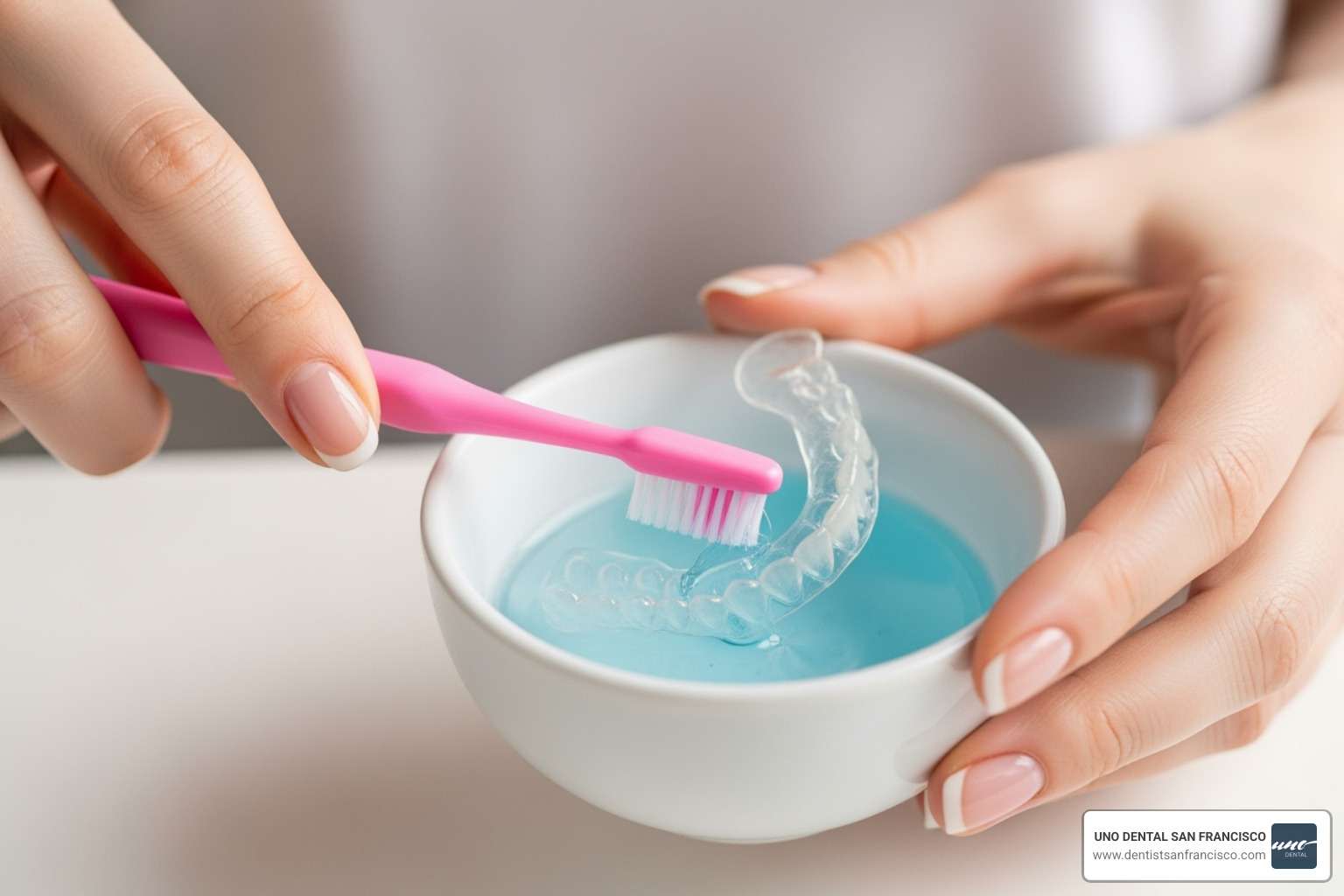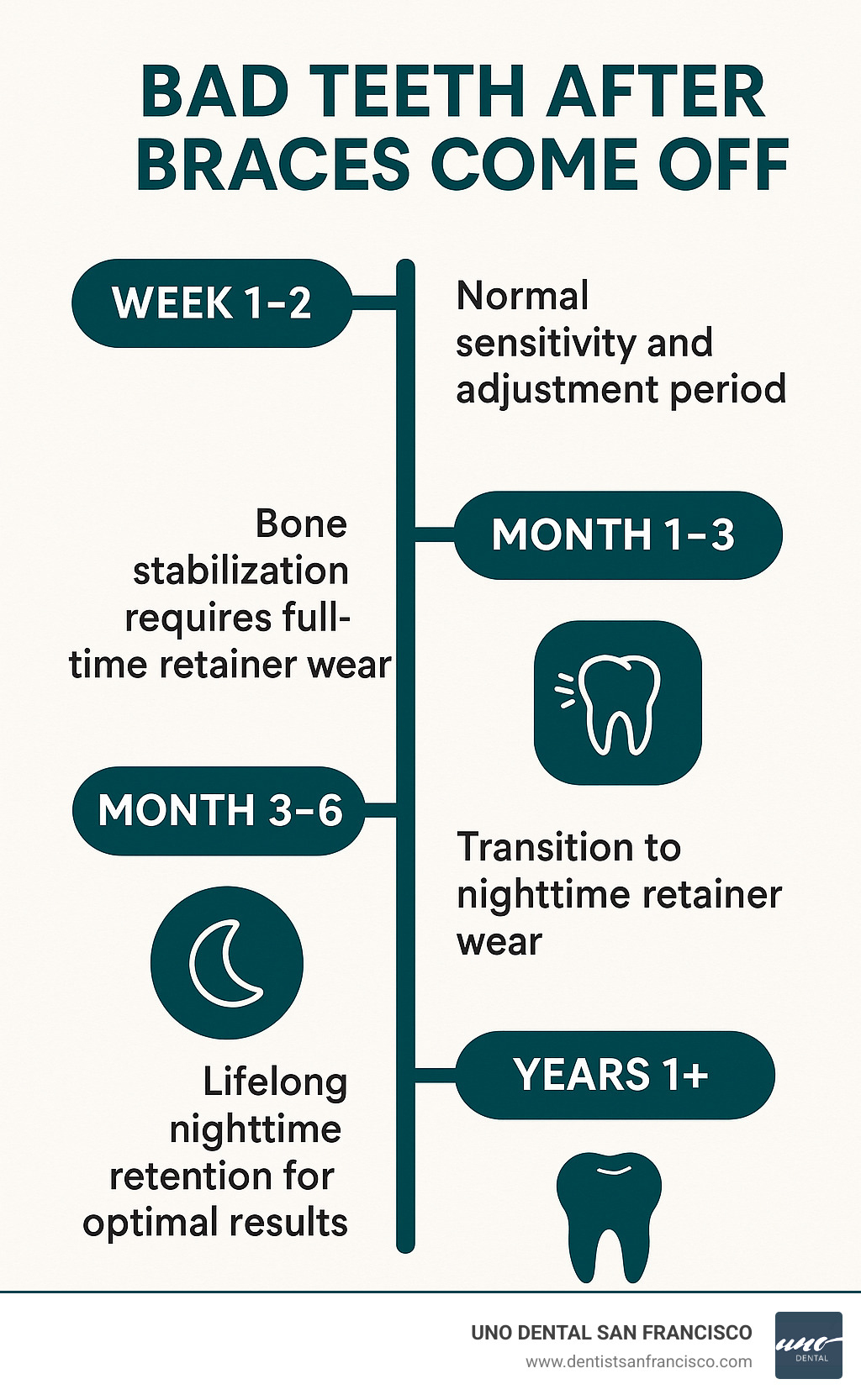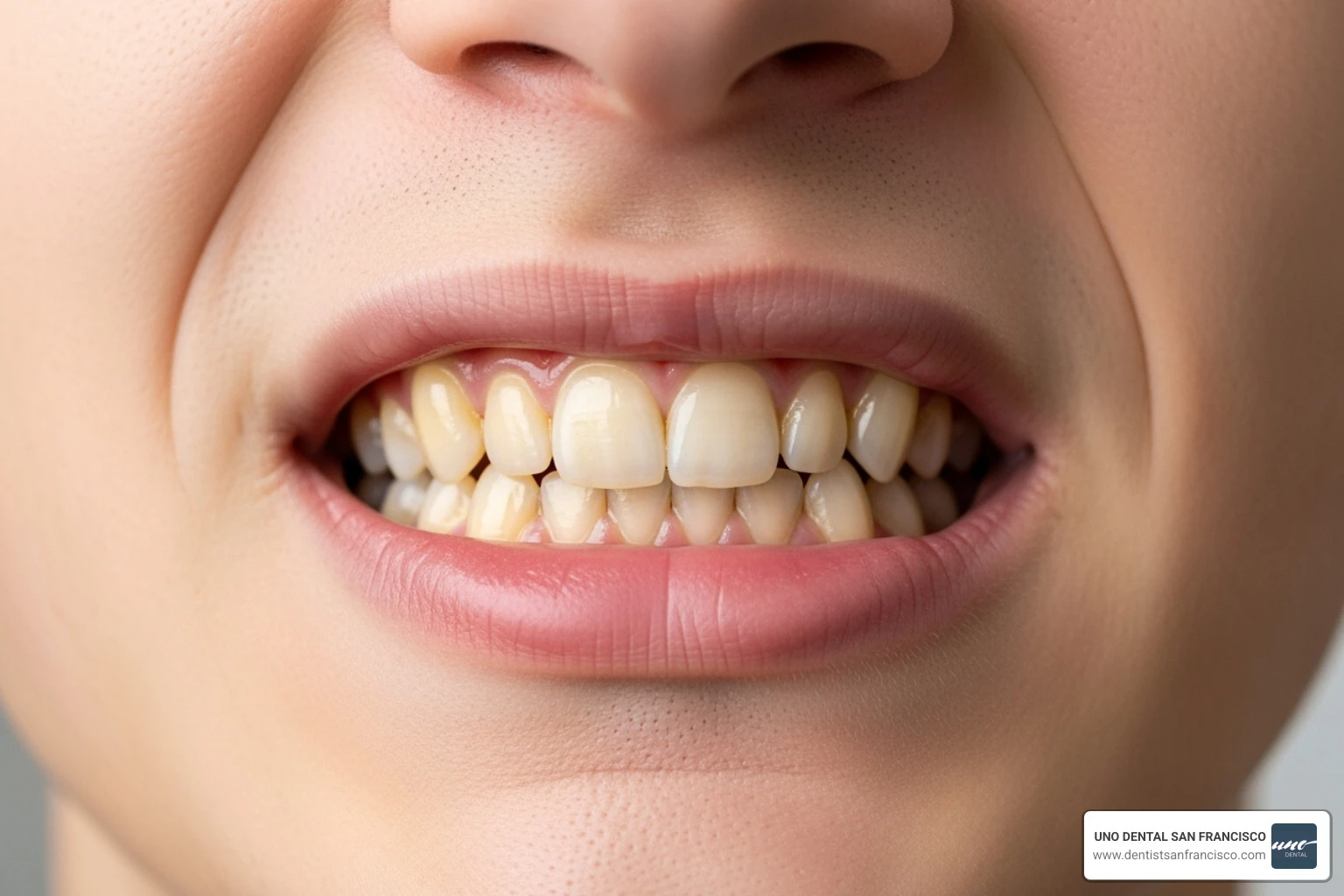
The Big Reveal... and the Big Disappointment
Bad teeth after braces come off is more common than you might think. After months or years of wearing braces, many patients expect perfect teeth right away. Instead, they're shocked to find yellow stains, shifting teeth, or bite problems that weren't there before.
Common issues after braces removal:
- Yellow teeth or white spots from plaque buildup around brackets
- Teeth shifting back to their original positions without proper retainer use
- Bite problems like jaw pain, headaches, or crooked teeth
- Sensitivity from pressure changes and gum adjustment
- Psychological adjustment to seeing teeth without brackets
The truth is, your orthodontic journey doesn't end when the braces come off. Your teeth have a natural tendency to move back to their original positions, and the bone around your teeth needs time to stabilize. Poor oral hygiene during treatment can also leave lasting damage that becomes visible once brackets are removed.
As Mohammad Aghiad Kandar DDS at UNO DENTAL SAN FRANCISCO, I've helped countless patients address bad teeth after braces come off through comprehensive post-orthodontic care and preventive treatments. My 15+ years of experience has shown me that most of these problems are preventable with the right knowledge and care plan.
What to Expect Immediately After Braces Removal
The moment your braces come off is exciting, but the first few days can feel strange. Your mouth has been a metal construction zone for a long time, and now everything is different.
Why You Might Have Bad Teeth After Braces Come Off
The excitement of getting your braces off can quickly turn to disappointment when you find your teeth aren't quite what you expected. Don't panic - understanding why these problems happen is the first step to fixing them.
Most issues with bad teeth after braces come off fall into three main categories: teeth shifting back to their old positions, discoloration from poor cleaning during treatment, and bite problems that weren't fully corrected. The good news? Most of these problems can be prevented or treated effectively.
The Science of Shifting: Why Teeth Move Back
Here's something that might surprise you: your teeth have a memory. Not the kind where they remember your birthday, but a biological memory stored in the periodontal ligaments and bone around each tooth. These structures "remember" where your teeth used to be and constantly try to pull them back to their original positions.
During your orthodontic treatment, your teeth moved through a fascinating process called bone remodeling. Think of it like renovating a house - the bone on one side of your tooth root gets broken down while new bone builds up on the other side. But here's the catch: this renovation project isn't finished when your braces come off.
The bone around your teeth needs months or even years to fully stabilize in its new position. Without a retainer to hold everything in place, your teeth will naturally drift back toward their old spots. It's like trying to hold a door open without a doorstop - eventually, it's going to swing shut.
Several factors make orthodontic relapse more likely. Insufficient retainer wear is by far the most common culprit. Many patients think they can skip wearing their retainer once their teeth "feel stable," but that's when problems start. Jaw growth in younger patients can also create new pressures that shift teeth out of alignment.
Wisdom teeth often get blamed for post-braces shifting, though the evidence for this is mixed. What's more certain is that bruxism (teeth grinding) and tongue thrust can definitely push teeth out of their new positions. Some patients develop these habits during treatment and don't realize they're undermining their results.
It's important to know the difference between normal settling and problematic shifting. Some minor movement is expected as your teeth find their natural resting position - think of it as fine-tuning. But if you notice significant changes in your tooth alignment, that's a sign something needs attention.
The Causes of Yellow Teeth and Stains
Yellow teeth after braces removal are incredibly common, and frankly, it's not entirely your fault. Cleaning around brackets and wires is genuinely difficult, even for the most dedicated brushers and flossers. Plaque - that sticky film of bacteria that forms on your teeth - loves to hide in all those hard-to-reach spots around your braces.
The areas around brackets and under wires become perfect hiding spots for plaque buildup. Over time, this plaque doesn't just sit there innocently - it actively damages your teeth through acid production. This leads to two main types of discoloration that become visible once your braces are removed.
Decalcification creates those chalky white spots that many patients notice after braces removal. These spots are actually areas where acid-producing bacteria have started to dissolve your tooth enamel. The technical term is enamel demineralization, but what it really means is that your tooth structure has been weakened and changed color. Unfortunately, severe white spots can be permanent.
General yellowing is usually more treatable and comes from surface stains and plaque buildup. You might notice that the areas that were covered by brackets look different from the exposed parts of your teeth. This happens because the covered areas were protected from some staining but also couldn't be cleaned as effectively.
Your diet during orthodontic treatment plays a bigger role than you might think. Foods and drinks high in sugar feed the bacteria in plaque, while acidic foods like citrus fruits and sodas can directly weaken your enamel. Dark-colored foods and drinks like coffee, berries, and soda can cause direct staining that's harder to remove when you have braces.
Enamel erosion is another concern that can contribute to yellowing. When acid weakens your enamel, it can expose the underlying dentin, which is naturally more yellow than the white enamel surface. This is why some patients notice their teeth look more yellow overall after braces removal.
Understanding an Incorrect Bite After Braces
Sometimes your teeth can look perfectly straight but still not function properly together. This can be incredibly frustrating, especially after investing so much time and money in orthodontic treatment. Bite problems after braces can develop for several reasons, including incomplete treatment, poor compliance during treatment, or natural settling that affects how your teeth come together.
The signs of a bad bite aren't always obvious at first. Jaw pain or TMD symptoms like clicking, popping, or aching in your jaw joint are common red flags. Many patients also experience headaches, particularly in the morning or after eating, which can be caused by nighttime teeth grinding or jaw muscle tension.
Crooked or crowded teeth returning is an obvious sign that something's not right, especially if your retainer feels tight or difficult to insert. Some patients notice they're accidentally biting their tongue more frequently, which can indicate that their bite relationship has changed.
Teeth grinding often increases when the bite isn't quite right, as your jaw muscles try to find a comfortable position. You might notice increased wear on your teeth or wake up with a sore jaw.
Common bite problems that may persist or develop after braces include several types of misalignment. An overbite occurs when your upper teeth significantly overlap your lower teeth, while an underbite is the opposite - your lower teeth protrude beyond your upper teeth. A crossbite happens when your upper teeth fit inside your lower teeth instead of outside them. An open bite means your front teeth don't touch when your back teeth are together.
These bite issues can develop if the orthodontic treatment didn't fully address underlying skeletal or muscular problems, or if your teeth have shifted significantly after treatment. The important thing to remember is that these problems are treatable, but they require professional attention to prevent them from getting worse.
Your Action Plan: How to Fix and Prevent Post-Braces Problems
The good news is that most post-braces problems can be prevented or effectively treated with the right approach. Here's your comprehensive action plan.
The #1 Rule: Wear Your Retainer
If there's one thing I tell every patient when their braces come off, it's this: your retainer is your best friend. Wearing your retainer as directed is absolutely crucial for preventing bad teeth after braces come off. Without it, your teeth will start moving back to their original positions faster than you'd think possible.
Understanding the different types of retainers) can help you take better care of yours. Hawley retainers are the classic wire-and-acrylic style that's been around for decades. They're incredibly durable and can last several years with proper care. Plus, they're adjustable if minor tweaks are needed.
Clear plastic retainers (also called Essix retainers) are nearly invisible and comfortable to wear. They're popular because they don't affect your speech as much, but they're less durable than Hawley retainers. Clean them daily with lukewarm water - never hot water, which can warp the plastic.
Fixed or permanent retainers are thin wires bonded to the back of your teeth. They provide continuous retention without you having to remember to wear them. However, they require special flossing techniques and can accumulate plaque if not cleaned properly.
Most orthodontists recommend wearing retainers full-time for the first 3-6 months after braces removal, then transitioning to nighttime wear. But here's what many patients don't realize: many professionals now recommend nighttime retainer wear for life to maintain optimal results.
If your retainer is lost or broken, don't panic - but do act fast. Contact your orthodontist immediately because teeth can shift within days. Keep your retainer case with you at all times to prevent loss. Trust me, replacing a retainer is much cheaper than getting braces again.
How to Address Yellowing and Discoloration
If you're dealing with yellow teeth or stains after braces, don't worry - several treatment options can help restore your smile's brightness. The key is choosing the right approach for your specific situation.
Professional dental cleaning should be your first step. Our dental hygienists can remove plaque and surface stains that accumulated during your orthodontic treatment. This cleaning often reveals the true extent of any discoloration and provides a clean foundation for other treatments.
In-office whitening is the fastest and most effective option, typically taking 1-2 hours to complete. We can brighten your teeth several shades in a single visit. At-home whitening kits with custom trays from your dentist offer gradual whitening that you can control at your own pace.
Whitening toothpaste helps maintain results but has limited effectiveness on its own. Over-the-counter strips are convenient but less effective than professional options. For best results, stick with professional treatments.
For more severe discoloration, advanced treatments may be necessary. Microabrasion can remove surface-level white spots and stains. Composite bonding covers discolored areas with tooth-colored material that matches your natural teeth. Veneers are porcelain shells that completely cover the front of teeth for dramatic results.
At UNO DENTAL SAN FRANCISCO, we often recommend waiting a few weeks after braces removal before starting whitening treatments. This allows your teeth to adjust and ensures even results across all tooth surfaces.
Improving Your Oral Hygiene Routine Now That Braces Are Off
One of the biggest advantages of having your braces removed is how much easier it becomes to maintain excellent oral hygiene. Take advantage of this opportunity to establish healthy habits that will protect your investment in orthodontic treatment.
Now that you can brush and floss normally, don't skip this crucial step. How to brush and floss correctly involves brushing for at least two minutes, covering all surfaces with gentle circular motions rather than aggressive scrubbing. Floss between every tooth, including behind your back molars, and be gentle with your gums, especially if they're still sensitive.
Use a soft-bristled toothbrush with fluoride toothpaste twice daily. Floss daily - seriously, every day. The freedom to floss properly after months or years of struggling with braces is liberating. Antimicrobial mouthwash helps prevent plaque buildup and keeps your breath fresh. Remember to replace your toothbrush every 3-4 months or when bristles fray.
Regular dental check-ups are more important than ever after braces. We recommend scheduling a comprehensive exam and cleaning within a few weeks of braces removal. This allows us to identify any issues early and create a maintenance plan for your new smile.
At UNO DENTAL SAN FRANCISCO, we've seen how proper post-braces care can make the difference between a smile that lasts a lifetime and one that requires additional treatment. The habits you establish now will determine how your smile looks years down the road.
Frequently Asked Questions About Teeth After Braces
How long do I have to wear my retainer?
Here's the truth that many patients don't want to hear: you'll probably need to wear your retainer forever, at least at night. I know it sounds overwhelming, but let me break down why this lifelong commitment is so important.
Your orthodontist will typically recommend full-time retainer wear for the first 3-6 months after your braces come off. During this crucial period, your bone and ligaments are still adapting to your teeth's new positions. Think of it like healing from surgery - your mouth needs time to stabilize.
After this initial period, most patients can transition to nighttime wear only. This is when many people breathe a sigh of relief, thinking they're almost done. But here's where it gets tricky: your teeth have a natural tendency to shift throughout your entire life, even if you never had braces.
What happens if you stop wearing your retainer? Unfortunately, teeth will gradually drift back toward their original positions. This shifting can begin within just a few days of stopping retainer wear, and it often accelerates over time. I've seen patients who stopped wearing their retainers after a few years, only to watch their beautiful straight smile slowly disappear.
The good news is that nighttime retainer wear becomes a habit pretty quickly. Most of my patients tell me they feel "off" sleeping without their retainer after just a few weeks of consistent use.
Can my shifted teeth be fixed without getting braces again?
This is probably the most common question I hear from patients dealing with bad teeth after braces come off. The answer depends on how much your teeth have shifted and how quickly you address the problem.
For minor shifts, you have several options that don't involve traditional braces again. Sometimes your orthodontist can make adjustments to your existing retainer to gradually guide teeth back into position. Clear aligner therapy like Invisalign can also be highly effective for correcting small amounts of relapse.
I've had patients who caught their shifting early and were able to correct it with just a few months of clear aligners. One patient noticed her bottom teeth getting slightly crowded and came in right away. We used a short series of aligners to get everything back on track, and she was thrilled to avoid braces again.
For moderate to severe relapse, the options become more limited. Significant shifting often requires traditional braces again or more extensive clear aligner treatment. Sometimes we need to use a combination of approaches to achieve the best results.
The key is timing. The longer you wait to address shifting teeth, the more difficult and expensive treatment becomes. If your retainer feels tight when you try to put it in, or if you notice visible changes in your smile, don't wait - contact your orthodontist immediately.
When should I see my orthodontist about problems after braces?
Knowing when to seek professional help can save you time, money, and frustration. Here are the warning signs that shouldn't be ignored:
Contact your orthodontist immediately if you notice significant visible shifting of your teeth. This might look like crowding returning, gaps opening up, or individual teeth rotating out of position. Even small changes can indicate bigger problems developing.
If your retainer doesn't fit properly, this is a red flag. A retainer that feels very tight, won't go in all the way, or causes pain when you try to wear it means your teeth have already started moving. Don't try to force it - you could damage your teeth or the retainer.
A broken or lost retainer is always an emergency. I can't stress this enough: don't wait to replace it. Teeth can shift surprisingly quickly, sometimes within just a few days. Call your orthodontist's office right away, even if it's after hours.
Persistent pain in your teeth or jaw that doesn't improve after a few days should also be evaluated. While some discomfort is normal right after braces removal, ongoing pain could indicate bite problems or other issues that need attention.
Concerns about bite alignment are worth discussing with your orthodontist. If you're having difficulty chewing, notice your jaw clicking or popping, or experience frequent headaches, these could be signs that your bite isn't quite right.
At UNO DENTAL SAN FRANCISCO, I always tell my patients that it's better to call with a concern that turns out to be nothing than to wait and let a small problem become a big one. Early intervention is almost always more effective and less expensive than waiting until problems become severe.
Your orthodontic investment doesn't end when the braces come off. With proper care and attention, you can maintain your beautiful smile for life.
Your Lifelong, Beautiful Smile Starts Now
Your journey to a perfect smile doesn't end when the orthodontist clips off those brackets - it's actually just beginning. The truth is, bad teeth after braces come off is almost entirely preventable when you understand what's needed and commit to protecting your investment.
Think about it: you've spent months or years wearing braces, attending appointments, and dealing with the inconvenience. Now that you have the straight teeth you've always wanted, the last thing you want is to watch them shift back or develop new problems.
The foundation of your lifelong smile success starts with retainer compliance. This isn't negotiable - it's the single most important factor in maintaining your results. Whether you have a Hawley retainer, clear plastic retainer, or fixed retainer, wearing it as directed prevents the shifting that causes so many post-braces disappointments.
Professional cleanings become your second line of defense. After months of navigating around brackets and wires, your teeth deserve a thorough professional cleaning to remove any stubborn plaque and surface stains. This fresh start sets you up for easier maintenance going forward.
Early intervention is your best friend when it comes to post-braces problems. If your retainer feels tight, if you notice any shifting, or if you're concerned about discoloration, addressing these issues quickly saves you time, money, and frustration down the road.
The good news? Excellent oral hygiene is so much easier now that your braces are off. No more threading floss under wires or trying to brush around brackets. This is your chance to establish healthy habits that will keep your smile beautiful for decades.
At UNO DENTAL SAN FRANCISCO, we understand that your orthodontic journey represents a significant investment - both financially and emotionally. That's why we're committed to helping you maintain the beautiful smile you've worked so hard to achieve. Our comprehensive approach includes post-orthodontic care, professional whitening treatments, and preventive care custom specifically to your needs.
Dr. Mohammad Aghiad Kandar and our team have seen how proper post-braces care can make the difference between a smile that lasts a lifetime and one that disappoints. We believe in building long-term partnerships with our patients, supporting you through every phase of your oral health journey.
Regular dental check-ups help us catch any issues before they become serious problems. We recommend scheduling your first post-braces appointment within a few weeks of removal, then maintaining regular visits to monitor your progress and address any concerns.
Your dream smile is worth protecting. The straight, healthy teeth you now have can stay that way with the right care and professional support. Explore our comprehensive dental services and let us help you maintain the beautiful smile you've earned.
